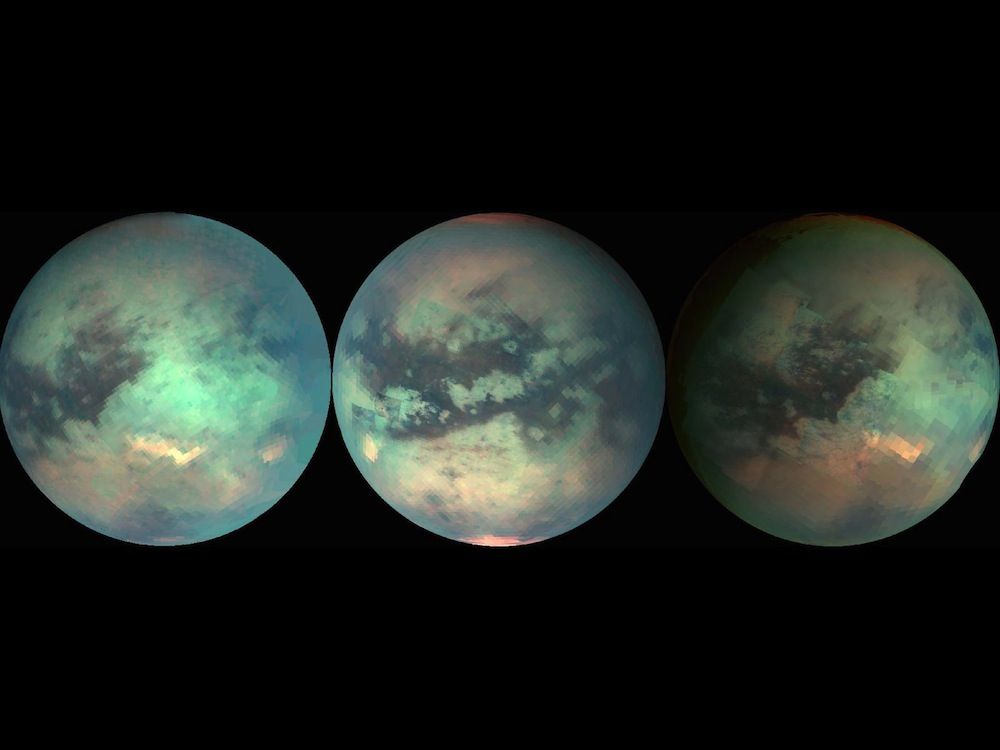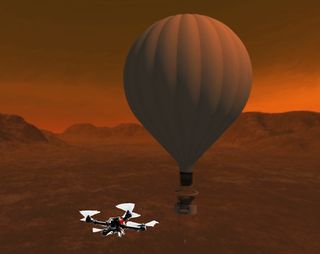Titan Tech: Lightweight Drone Could Explore Saturn Moon

Sailing the soupy atmosphere of Titan, Saturn's largest natural satellite, an interplanetary balloon could one day release a small drone to explore the moon's swamp-like surface.
The so-called "Titan Aerial Daughtercraft" mission concept recently received a $100,000 Phase 1 grant from the NASA Innovative Advanced Concepts program, a sort of sandbox for the agency to explore far-out and futuristic ideas.
As part of this proposed mission, a quadcopter drone would "jump" from a mothership-type balloon to explore the surface of Titan; the drone would then return to the balloon to recharge for the night, the researchers said. Both vehicles would be used to investigate Titan's hydrogen- and carbon-rich environment, which some scientists think resembles the composition of Earth's atmosphere early in its history. [In Photos: Stunning Views of Titan from Cassini]
"Scientists call the chemistry on Titan 'prebiotic,' meaning that they think Earth could have had similar chemistry before life arose," Larry Matthies, lead researcher of the new concept, told Live Science.
Because of the potential similarities to the atmosphere of primordial Earth, scientists have long wanted to take a closer look at Titan.
"One of the top priorities now is to investigate the surface and chemical processes at the surface," said Matthies, a senior research scientist at the NASA Jet Propulsion Laboratory in Pasadena, California, and leader of the robotic and mobility group's computer vision section.
But there's no guarantee this mission will get beyond the brainstorming phase, because the concept will have to compete with other ideas for money at each stage of NASA's Innovative Advanced Concepts program. It would take about 10 years to make it through the agency's early stage programs to the next stage — actually designing the spacecraft — which, again, would take several years to complete.
Sign up for the Live Science daily newsletter now
Get the world’s most fascinating discoveries delivered straight to your inbox.

Even if NASA selects the mission to Titan, Matthies said it would be at least two decades before the idea takes flight.
Mysterious orange haze
Titan became an enticing destination after the Voyager 1 and Voyager 2 spacecraft flew past Saturn in the 1980s. To scientists' surprise, an orange haze completely enveloped the large moon, obscuring its surface from the optical cameras aboard the Voyager spacecraft.
In 2005, scientists finally got a closer view of Titan, when the Huygens probe detached from the Cassini orbiter and touched down on the surface of Saturn's moon. Its mission was brief — it communicated with Cassini for about 90 minutes, as expected — but even that brief glimpse helped scientists glean more information about Titan's atmosphere and its soft surface.
Cassini itself has mapped Titan with radar, revealing bodies of liquid that could be filled with methane and ethane. These substances are thought to be part of Titan's "water cycle," which is believed to resemble Earth's, except with methane and ethane instead of water.
Because the moon's surface is so soft, a conventional rover might have difficulty navigating the terrain, the researchers said. A quadcopter drone, though, would be able to jump to the surface, fly around and then return to the balloon overhead.
The mothership would have a nuclear (radioisotopic) generator on board — providing NASA can get its hands on enough plutonium-238; supplies are running scarce worldwide due to the cost of production, among other factors.
New ideas needed
Elements of the mission to Titan have been studied before, such as the plausibility of sending a balloon deep into the solar system, or the ability to design a quadcopter drone to explore planets and moons.
The balloon, either filled with helium or heated samples of the local atmosphere, would launch inside a traditional rocket, the researchers said. It would likely be inflated in midair, a challenging idea that Matthies said initial studies have shown to be doable.
Flying on Titan' would be slower because it's atmosphere is four times thicker than Earth's, producing more drag. Also, the time lag in communications between Earth and Titan would require the drone to "think" independently, about matters such as how to find the mothership balloon and how to deposit samples for analysis.
"You need very lightweight, high-performance electronics that don't draw a lot of power for this," Matthies said, suggesting a smartphone processor might be all the computing power needed for this type of mission.
Phase 1 of the NASA Innovative Advanced Concepts program lasts about nine months, at which point the Titan quadcopter mission would re-enter the pool of competitive proposals for the next stage of funding.
Follow Elizabeth Howell @howellspace, or Live Science on Twitter @livescience. We're also on Facebook & Google+. Original article on Live Science.

Elizabeth Howell was staff reporter at Space.com between 2022 and 2024 and a regular contributor to Live Science and Space.com between 2012 and 2022. Elizabeth's reporting includes multiple exclusives with the White House, speaking several times with the International Space Station, witnessing five human spaceflight launches on two continents, flying parabolic, working inside a spacesuit, and participating in a simulated Mars mission. Her latest book, "Why Am I Taller?" (ECW Press, 2022) is co-written with astronaut Dave Williams.












